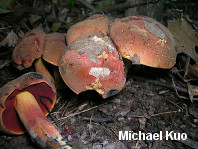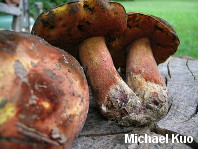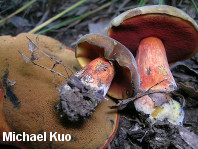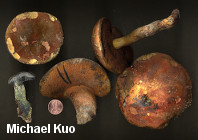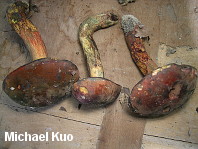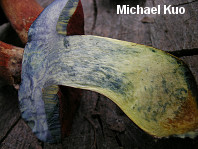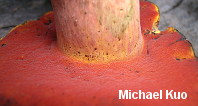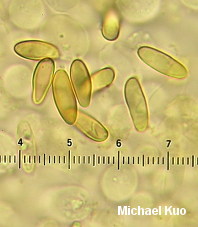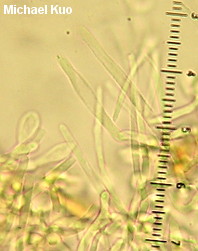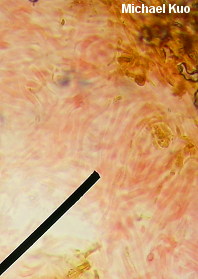| Major Groups > Boletes > Red-Pored Boletes > Boletus subluridellus |

|
Boletus subluridellus [ Basidiomycota > Boletales > Boletinae > Boletaceae > Boletus . . . ] by Michael Kuo This red-pored, oak-loving bolete features a deep red to brownish red cap that is initially covered with a thin layer of brownish fuzz. At first, the cap surface has a resinous feel to it--but by maturity it feels soft and leathery. When fresh the cap bruises dark violet, rather than blue--and the stem is yellow underneath a healthy coating of red. Microscopic features, which should be confirmed for positive identification, include elongated caulocystidia and pileipellis elements that turn red in Melzer's reagent. Description: Ecology: Mycorrhizal with oaks; growing alone, scattered, or gregariously; summer; possibly widely distributed east of the Great Plains. Cap: 4-13 cm across; convex, becoming broadly convex; dry; finely velvety when young, with a resinous feel; sometimes becoming more or less bald by maturity; brownish red to orangish red, with a thin layer of brownish to olive brown fuzz that can be rubbed away; sometimes with mottled yellow and red shades; when fresh bruising deep violet, then slowly blackish; margin at first inrolled and yellowish, with a narrow sterile overhang. Pore Surface: Initially dark orangish red; fading to orange; bruising promptly dark blue or nearly black; 3-4 round pores per mm; tubes to 1 cm deep. Stem: 4-10 cm long; 1-1.5 cm thick; more or less equal; often curved near the base; not reticulate; yellow, coated with red, especially toward the base; bruising blue; basal mycelium whitish to yellow, bruising dark red. Flesh: Yellow in the cap; darker yellow in the stem; promptly bluing when sliced. Odor and Taste: Not distinctive. Chemical Reactions: Ammonia negative on cap surface; orangish on flesh. KOH orange to red on cap surface; orange on flesh. Iron salts negative on cap surface; negative on flesh. Spore Print: Olive. Microscopic Features: Spores 9-15 x 3.5-4.5 µ; smooth; fusiform; yellow in KOH. Hymenial cystidia inconspicuous; yellow in KOH; widely fusiform; to about 50 µ long. Pileipellis a tightly packed trichoderm of hyphae 2.5-5 µ wide; yellowish to yellow in KOH; terminal elements cylindric with rounded apices, or aciculate, with subacute apices. Some pileipellis and subcuticular elements pinkish red in Melzer's reagent. Caulocystidia of two types: fusoid-ventricose, yellow in KOH, 25-25 µ long; or fusiform to fusoid-ventricose with an extended mucro, to 100+ µ long. REFERENCES: Smith & Thiers, 1971. (Smith, Smith & Weber, 1981; Phillips, 1991/2005; Bessette, Roody & Bessette, 2000; Roody, 2003; Binion et al., 2008.) Herb. Kuo 07250305, 07060705, 07140807. This site contains no information about the edibility or toxicity of mushrooms. |
© MushroomExpert.Com |
|
Cite this page as: Kuo, M. (2013, December). Boletus subluridellus. Retrieved from the MushroomExpert.Com Web site: http://www.mushroomexpert.com/boletus_subluridellus.html |
